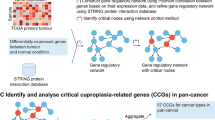Abstract
Neuroblastomas show remarkable biological heterogeneity, resulting in favorable or unfavorable outcomes. To survey the differences in gene expression profiles between favorable and unfavorable neuroblastomas, we analyzed ten favorable neuroblastoma samples from patients whose tumors consequently regressed or matured and ten unfavorable tumor samples from patients who consequently died of disease using the microarray technique. In each sample, total RNA was labeled with Cy3 or Cy5 in reverse-trancriptase reaction and hybridized with our original microarray prepared with a cDNA library of human fetal brain. Microarray analysis revealed that 43 genes, including MYCN, hTERT, NME1 and cell cycle regulatory protein-coding genes, were highly expressed in unfavorable neuroblastomas, while another 80 genes were detected as highly expressed in favorable tumors, including neuronal differentiating genes and apoptotic inducing genes. Among favorable neuroblastoma samples, highly expressing genes in regressing tumors were different from those in maturing tumors. Expression profiling data revealed the existence of up-regulated and down-regulated gene clusters in favorable and unfavorable tumors. This cluster analysis is a powerful procedure to distinguish unfavorable tumors from favorable tumors as well as regressing tumors from maturing tumors among favorable tumors. The information obtained from expression profiling would clarify the key genes for cell growth, regression or maturation of neuroblastoma cells, and these genes will become diagnostic and therapeutic targets in human neuroblastoma in the future.


Similar content being viewed by others
References
Westermann F, Schwab M (2002) Genetic parameters of neuroblastomas. Cancer Lett 184:127–147
Brodeur GM (2003) Neuroblastoma: biological insights into a clinical enigma. Nat Rev Cancer 3:203–216
Schena M, Shalon D, Davis RW, et al (1995) Quantitative monitoring of gene expression patterns with a complementary DNA microarray. Science 270:467–470
Osin P, Shipley J, Lu YJ, et al (1998) Experimental pathology and breast cancer genetics: new technologies. Recent Results Cancer Res 152:35–48
Hiyama E, Hiyama K (2002) Clinical application of microarrays as a tool of understanding cancer biology. In: Pandalai SG (ed) Recent research developments in cancer. Transworld Research Network, Kerala, India 4, pp 675–692
Zhang K, Zhao H (2000) Assessing reliability of gene clusters from gene expression data. Funct Integr Genomics 1:156–173
Gluer S, Zense M, von Schweinitz D (1998) Cell adhesion molecules and intermediate filaments on embryonal childhood tumors. Pathol Res Pract 194:773–780
Gomez-Santos C, Ambrosio S, Ventura F, et al (2002) TGF-beta1 increases tyrosine hydroxylase expression by a mechanism blocked by BMP-2 in human neuroblastoma SH-SY5Y cells. Brain Res 958:152–160
Godfried MB, Veenstra M, Sluis P, et al (2002) The N-myc and c-myc downstream pathways include the chromosome 17q genes nm23-H1 and nm23-H2. Oncogene 21:2097–2101
Hiyama E, Hiyama K, Yokoyama T, et al (1995) Correlating telomerase activity levels with human neuroblastoma outcomes. Nature Med 1:249–255
Hiyama E, Hiyama K, Ohtsu K, et al (1997) Telomerase activity in neuroblastoma: is it a prognostic indicator of clinical behavior? Eur J Cancer 33:1932–1936
Hoehner JC, Hedborg F, Eriksson L, et al (1998) Developmental gene expression of sympathetic nervous system tumors reflects their histogenesis. Lab Invest 78:29–45
Kushner BH, Cheung NK, LaQuaglia MP, et al (1996) International neuroblastoma staging system stage 1 neuroblastoma: a prospective study and literature review. J Clin Oncol 14:2174–2180
Shimada H, Chatten J, Newton WJ, et al (1984) Histopathologic prognostic factors in neuroblastic tumors: definition of subtypes of ganglioneuroblastoma and an age-linked classification of neuroblastomas. J Natl Cancer Inst 73:405–416
Acknowledgements
This research was partially supported by a grant-in-aid for scientific research (A) (no. 13307050 and 15209058) from the Ministry of Education, Culture, Sports, Science and Technology and for Cancer Research (13-20) from the Ministry of Health, Labor and Welfare of the Government of Japan.
Author information
Authors and Affiliations
Corresponding author
Rights and permissions
About this article
Cite this article
Hiyama, E., Hiyama, K., Yamaoka, H. et al. Expression profiling of favorable and unfavorable neuroblastomas. Ped Surgery Int 20, 33–38 (2004). https://doi.org/10.1007/s00383-003-1077-3
Published:
Issue Date:
DOI: https://doi.org/10.1007/s00383-003-1077-3




